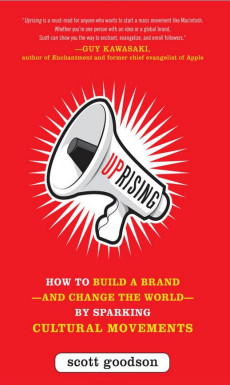
Uprising: How to Build a Brand—and Change the World—by Sparking Cultural Movements
Scott Goodson
256 pages, McGraw-Hill, 2012
Scott Goodson is a co-founder of the global marketing firm StrawberryFrog, and he has worked with leading worldwide brands, including Ikea, Pfizer, Pepsi, Procter & Gamble, Mitsubishi, Smart, and Microsoft. In Uprising, he argues that “movement marketing” is the best—and perhaps only—way for companies to connect with consumers in the age of social media, and when done effectively the interaction between companies and consumers can lead to positive social change.
Goodson has written two books: one on how marketers can engage groups with shared passions, beliefs, and ideas to sell products and develop brands; and one on how marketers can help foster cultural and social movements “to build a better, fairer, more sustainable, and more interesting world.” Goodson avoids the contradictions inherent in this argument—i.e., can corporate branding and consumption really lead to sustainability?—but he does provide strong, practical tips for how corporate and nonprofit brands can connect with people in an increasingly global, technologically connected age.
Goodson cites Clay Shirky, Seth Godin, and other marketing and communications experts in declaring that the old way of marketing—pitching a product to the largest possible audience through mass media—is dying. He argues that the best way to reach people is to look for topics and causes around which they are already gathering and align one’s brand with those topics or causes. This inverts the old marketing process; companies need to start with what is going on in the culture, rather than focus on their product or service. Goodson lays out his thesis in the first and last chapters of the book and provides a persuasive and entertaining history of the shift from the old marketing model to the new one in Chapter 2. In Chapters 3 to 7 he details the changes driving this new model and how to put it into practice. Throughout, Goodson provides dozens of short case studies about for-profit and nonprofit campaigns he offers as examples of movement marketing.
Goodson distinguishes the new movement marketing model from the old model: “Instead of marketing and advertising being focused on the individual, marketers must learn to understand and relate to people in interconnected groups; instead of convincing people to believe an ad message, marketers must try to tap into what it is that people already believe and care about; instead of being focused on selling, the way to connect with movements is to be dedicated to sharing; instead of controlling the message, marketers must learn to relinquish control and let the movement do what it will with that message; perhaps most radical of all, companies and brands must learn to stop talking about themselves and to join in a conversation that is about anything and everything but their product.”
Goodson’s concept of “movement” could be tighter. He anchors his definition in people gathering around what Shirky calls “shared endeavors.” Goodson notes that not all movements are culturally or politically momentous, like the civil rights, women’s, and environmental movements, but he often discusses cultural movements, social movements, and “purposeful” movements without clearly distinguishing among them.
Though Goodson’s aim seems primarily to revolutionize corporate marketing, social sector enterprises may benefit the most from Uprising. Ironically, the most compelling examples of movement marketing Goodson offers are nonprofits and social enterprises, for which the cause, the movement itself, is the brand—for example, Charity: Water, Aging in Place, and DIY.
When Goodson turns to corporate marketing, he is not as persuasive that branding campaigns add up to movements. Pepsi’s Refresh campaign, one of Goodson’s most cited cases, attracted more than 76 million votes for community improvement ideas submitted by consumers, but the campaign seems more cause marketing and prize philanthropy than a movement. Jim Beam’s Bold Choice campaign and Microsoft’s IdeaWins campaign appeal to individual dreams of growing a small business or finding fulfillment in an encore career, but likewise lack a movement’s shared endeavor. Toms Shoes is a more complicated case. The company’s marketing strategy for selling its product is to tap people’s interests in being, or feeling, philanthropic. (Every pair of shoes sold leads to a pair donated.) Toms’ distribution of shoes and eyeglasses to people in need is a great contribution—but again, is it a movement?
Corporate engagement marketing of the kind shown in most of Goodson’s examples is certainly an improvement over the old marketing model, and it may be valuable in itself. But I could not escape feeling that for something to be more than niche marketing, there must be an appeal to some shared goal as well as to social change.
Still, Goodson is undeniably right in observing the rise in the number of people seeking connection to shared passions through, and perhaps because of, technology. Uprising will help both corporate and social sector leaders seeking to connect their brand or cause to people who share a mutual passion, and we all will benefit if Goodson succeeds in persuading more companies to support movements for good.

